Replacing a ThermocoupleInside the burner compartment of your gas water heater, right in front of the pilot light, is a small metal cylinder called a thermocouple (unless you have a unit with electronic ignition). The thermocouple is a safety device that senses when the pilot light is burning. If the pilot light goes out, the thermo couple signals the gas valve to remain closed until the pilot light is relit. If your burner is shut off and the pilot light refuses to stay lit, a worn-out thermocouple is the likely culprit. Remove the old thermocouple, measure it and buy the same size replacement at a hard ware store. Also, take the opportunity to clean the burner while it’s out. Before beginning, turn off the gas to the water heater and turn the temperature control valve to OFF. |
|
| 1. Remove the burner by disconnecting the burner gas line, pilot gas line and thermocouple. Pull lines out of the gas valve and remove the burner. |  |
| 2. Slide the old thermocouple out and push the new one in. Note the position and mount ing details of the old thermocouple and install the new one the same way. | 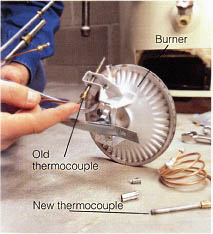 |
|
3. Reinstall the burner and reconnect the gas lines and thermocouple to the gas valve. Tighten the nuts with moderate pressure and test the gas connections for leaks by coating joints with soapy water and checking for bubbling. |
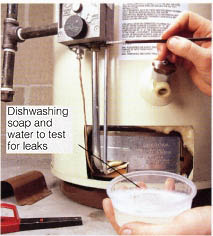
|


Replacing an Electric Heating Element
If you have an electric water heater that suddenly produces only lukewarm water, it’s very likely a heating element has gone bad. Since the lower element in a dual-element unit does 90 percent of the heating, that one usually wears out first.
First, shut off power to the water heater, remove access panels and use a voltage-sensing device to make absolutely certain there’s no power running through any of the wires.|
1. Shut off power. Disconnect two wires attached to the element and use a water- heater continuity tester to test each one. No light indicates a burned-out element. |
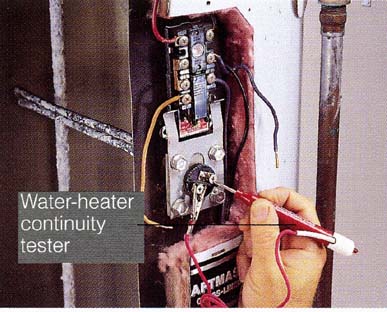 |
|
2. Shut off the cold-water supply and drain water from the tank. Remove the bad element by removing
the bolts holding its mounting bracket to the tank. |
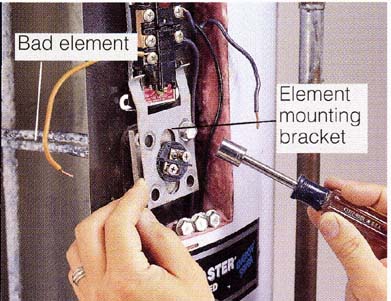 |
| 3. Replace the element with one that exactly matches the wattage, voltage, length and mounting style of the old one. Install the new element and gasket, close drain and refill tank. | 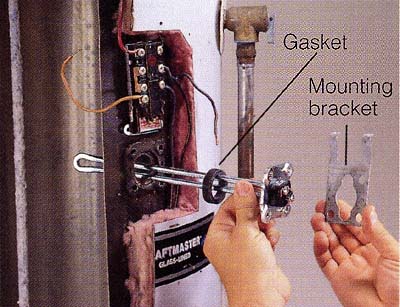 |
Shopping Tips: Tankless Water Heaters
Tankless water heaters, also called instant or on-demand, don’t heat and store 40 or 50 gal. (150 or 190 L) of water like conventional heaters. Instead, as water is needed, it’s heated with a blast of gas or electric resistance heat.
Tankless heaters have some substantial advantages. They can fit into small spaces. They have great longevity and will provide limitless hot water as long as they’re not overtaxed. And they save energy, because they don’t have to keep water hot while it’s not being used.
The disadvantages of tankless units are that they’re expensive and may require larger gas or electric lines and vents for installation. They are also foreign to some repair people, and only the largest units can keep pace while filling a large indoor bathtub or if several showers are being taken at one time.Links:
Consumer Guide to Home Energy Savings: Condensed Online Version
